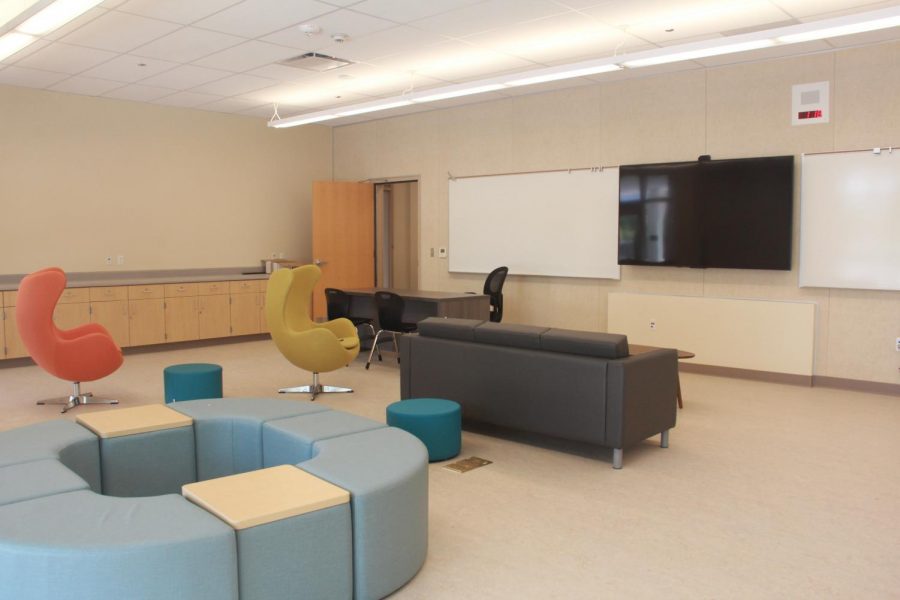Wellness Team reflects on new space, future goals
Following the completion of construction, the Wellness Center has relocated to room P-231 on the second floor of the new building, undergoing several changes with new plans discussed for the future.
One of the most notable changes is the expansion in space. “In our old lounge area, we [could] only really accommodate like eight to ten students comfortably, whereas now we [can fit] probably twenty,” wellness coordinator Genavae Pierre Dixon said. With more room, two additional couches have been added, as well as a larger resource library and a corner dedicated to sensory fidget toys.
The decor and space aren’t the only new additions. The Wellness Team has added Counseling and Support Services for Youth (CASSY) therapist Emily Rubens and wellness outreach worker Rosie Castillo to their staff. “This is my first year here,” Castillo said. “And I really love the fact that even though [the] Wellness Center seems to bring a lot of the stuff that people are struggling with, at the same time we also have a lot of opportunities to see students in a really great way.”
The team has been adjusting well to the relocation, agreeing that the center’s greatest benefit to students is the privacy of the new hallway. According to Lead CASSY Site Therapist Michelle Ramos, students check in and wait in the lobby while the sessions take place in private rooms. The hallway in-between the two allows for a smoother transition to a student’s session, as well as a feeling of confidentiality.
This helps create a better general atmosphere for students. “I like the flow that we have, the separation of the Wellness Center, and the privacy that [provides],” Ramos said. “It helps with confidentiality for those students.” Unlike the open space of the previous center, the separation establishes boundaries, making students feel more secure.
Ramos commented that because of this, more students are willing to visit and check-in. “I’d like to think that it’s going to be much more welcoming,” she said.
The Wellness Team plans to utilize these changes and work towards new projects. Some ideas include a weekly Flex session to hold hands-on workshops such as stress ball making and group meditation. Another idea is to continue the Heart and Wellness group—which ran expressive arts sessions—last year and branch out to activities that take advantage of the bigger space. The team is also working towards creating a gardening club and organizing therapy dog visits.
Future goals have been set as well. Dixon and Ramos hope that this year, the Wellness Center can focus on low-level interventions: raising awareness around symptoms that might arrive before a crisis, and how to prevent them early on. “By the time we support a student, they’re already in full panic mode, which means we’re missing a big section of what can be done for them,” Dixon said.
For her first year, Castillo hopes to raise awareness of mental health among parents and has worked with the outreach worker at Palo Alto High School to coordinate parent meetings and events. “Our students have really amazing insights,” said Castillo. “If we’re going to make some real change and make an actual impact on the wellness of our students, it’s really important to have the parents [contribute]. By doing that, we need to have them understand what it is that y’all are facing, because it’s a totally different perspective in a totally different world.”
To implement these new ideas, the Wellness Team is working with organizations such as the Children’s Health Council, Community Health Awareness Council, Adolescent Counseling Services and Parent Teacher Student Association, as well as the school psychologist and counselors to find the approach that works best for students. “I’m looking for therapeutic support that they might provide for the community,” Castillo said. “That way, I can link students and families to that support at their agencies.”
Castillo says that she has been impressed by the amount of knowledge that these organizations provide. “[A] lot of people don’t do this for the money, because if they did they wouldn’t be here,” she said. “We all know that we’re on a team together. I think that’s the best part of it: the fact that nobody feels like that they’re doing it alone.”
Your donation will support the student journalists of Henry M. Gunn High School. Your contribution will allow us to purchase equipment and cover our annual website hosting costs.


